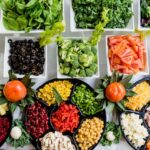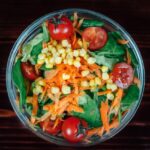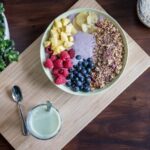Many people are hesitant to eat vegetables, but fruits and vegetables are an important part of a healthy diet. But what can you do if you don’t like the taste of most vegetables? Some people never outgrow their dislike of vegetables. Here are a few tips for changing your taste. One good way to make vegetables more appealing is to add spices and herbs to the food. Another good tip is to eat salads instead of avoiding them altogether. Salads are a great way to get a variety of vegetables in one meal.
Fruits and vegetables are a healthy part of a healthy diet
Vegetables and fruits contain disease-fighting phytochemicals. These compounds lower your risk for cardiovascular disease, high blood pressure, and diabetes. Many studies have also linked a diet rich in fruits and vegetables with reduced risk for cancer. Phytochemicals are also linked to a decreased risk of depression and Alzheimer’s disease. They are also useful for reducing inflammation, improving cholesterol levels, and lowering blood pressure.
Vegetables and fruits provide vitamins and minerals. They’re a good source of dietary fibre, which helps maintain a healthy gut and lowers your risk for bowel cancer and heart disease. You can even reduce your risk by substituting fruits and vegetables for foods high in saturated fat, trans fat, or salt. So, even if you don’t like vegetables, they’re still a healthy part of a healthy diet.
Many types of fruits and vegetables have a naturally sweeter taste. Sweet potato pie is a popular Thanksgiving dessert in the United States. Other naturally sweet vegetables include carrots, beets, rutabagas, and turnips. These vegetables have a sweet taste, but they’re not as high in sugar as fruits. If you’re not a fan of fruits, you can always buy canned fruit or vegetables. Remember to choose canned varieties without added sugar and syrup. Remember to choose whole fruits rather than fruit juices as they lose fiber when juiced.
Another way to increase fruit and vegetable intake is to buy them in the puree form. Try adding them to your favorite foods and meals. Try adding them to your favorite dishes as an appetizer. For example, you can add berries or avocado on your cereal, or use broccoli in an omelette. Another way to increase your child’s intake of fruit and vegetables is to add them to your breakfast. Try adding them to foods you already enjoy, such as cereal and toast.
Some people never outgrow a distaste for vegetables
While many people outgrow their dislike of vegetables, some people never grow out of it. The reason for this may be a heightened sensitivity to the bitter taste of some vegetables. These are the so-called “cruciferous” vegetables, such as broccoli and cauliflower. They have high amounts of lycopene, a chemical that irritates the taste buds. As a result, these people find it difficult to eat vegetables, and they never grow out of their dislike.
There are some people who are genetically predisposed to a distaste for vegetables. Research shows that one in five people can’t stand the taste of certain vegetables. Some of them are super-tasters, and they experience a greater level of bitterness when they cut or chew them. Others may experience an increase in bitterness as they get older. A genetic predisposition to dislike bitter vegetables may also play a role in some people’s distaste for these vegetables.
Some people have a genetically determined distaste for vegetables, based on saliva analysis. People with two copies of this gene, known as PAV, were twice as likely to be among the lowest-ranked vegetables on a list. These people have a higher risk of cardiovascular disease. They also reported eating the least amount of vegetables, according to research. However, it’s possible that the genes responsible for their distaste for vegetables are not linked with health problems.
Herbs and spices can change the taste of vegetables
While it’s hard to imagine that a spice can improve the flavor of vegetables, it’s true that it can. A recent study found that high school students consumed more vegetables seasoned with herbs and spices than middle schoolers did. Interestingly, adolescents became more willing to eat seasoned broccoli after repeated exposures. This finding indicates that repeated exposure to different flavors can make them more receptive to them.
When used appropriately, herbs and spices can significantly improve the taste of vegetables. The first step is to familiarize yourself with the different herbs and spices that will best improve the flavor of vegetables. Spices and herbs can be used separately or in combination to achieve a unique flavor profile. Experiment with different combinations and see what works best for you. Once you’ve mastered the basics of each herb and spice, you’ll be ready to add them to your next vegetable preparation.
While flavor and appearance are two important factors in vegetable evaluations, the latter has the highest importance among consumers. For example, in a study of four vegetables, people rated flavor as more important than appearance, while appearance had a smaller impact on liking. A strong bitterness in a vegetable is likely due to dietary phytonutrients acting as antioxidants, phytoestrogens, and enzyme inducers.
Other studies have also proposed that herbs and spices can improve the sensory properties of vegetables. One particular study involved the addition of dill weed and garlic powder to black beans and corn. While the findings are preliminary, it’s important to note that this research suggests a potential market for spice and herb seasonings on vegetables. It also provides further evidence that combining herbs and spices can increase the flavor of vegetables.
Salads are a good way to get a variety of veggies into one meal
If you don’t like vegetables, salads are a good way to include them in one meal. There are many ways to dress your salad, including olive oil, vinegar, sour cream, or hummus. To mix things up, you can add herbs and spices, such as chives or basil. If you don’t like vegetables, you can also try avocado-mayo, which is made by mixing an avocado with mayo and seasoning it with garlic, paprika, or salt.
While salads can be a fun way to get a variety of vegetables into a meal, they can also be tedious. Fortunately, there are a number of quick ways to make your salad and get a variety of veggies into one meal. A few minutes of prep work each day during your lunch break can go a long way. If you don’t like to prepare salads from scratch, try preparing one for lunch. If you have enough time, you can make a salad at work or on your lunch break. If not, keep reading for some tips to help you get the most from your salad.
Another great way to get more veggies into your diet is to add more fruit and vegetables to your diet. Pre-cut vegetables are convenient to prepare, and they can be easily added to your salads on the weekends. Salads are also a great way to include vegetables that you normally wouldn’t eat. If you don’t like vegetables, try making salads instead of eating them all separately.
Another great way to incorporate a variety of fruits and vegetables into your diet is to cook them yourself. You can use vegetable oil in a skillet or grill, and you can add chopped vegetables to a favorite chili recipe. This way, you can sneak more veggies into your favorite foods without compromising the quality. For example, if you don’t like vegetables, you can add a handful of chopped veggies to a chili recipe and have it be a meal.
Adding vegetables to other dishes
Adding vegetables to other dishes is an easy way to get more vegetables into your diet. It is not always easy, especially if you enjoy eating neatly-arranged plates. Fortunately, there are many ways to sneak vegetables into your favorite foods, and you may find something you love to eat. Try preparing vegetables in a way that you don’t mind tasting.
Whether you don’t like green vegetables or hate the taste of raw or boiled vegetables, a simple way to sneak vegetables into your meals is to add them to other dishes. Try adding broccoli, asparagus, spinach, or beets to your soups or sandwich buns. You can even roast Brussels sprouts instead of boiling them. Eating vegetables regularly will also increase your intake of important nutrients.
One way to sneak more vegetables into your meals is to blend them with your favorite foods. By blending them with your favorite foods, you’ll not even notice they’re there! It’s best to begin by adding a small amount and build up as your palate becomes accustomed to the taste. If you’re still unsure, add more vegetables as you get more comfortable with the idea.
Another way to sneak more vegetables into your diet is to cook them yourself. You can add pureed vegetables to stir-fried dishes or even meatloaf. Other ways to sneak in vegetables include putting them into smoothies, vegetable juices, and tomato carrot juice. Try steaming, stir-frying, or oven-roasting your vegetables instead of frying them in oil.









